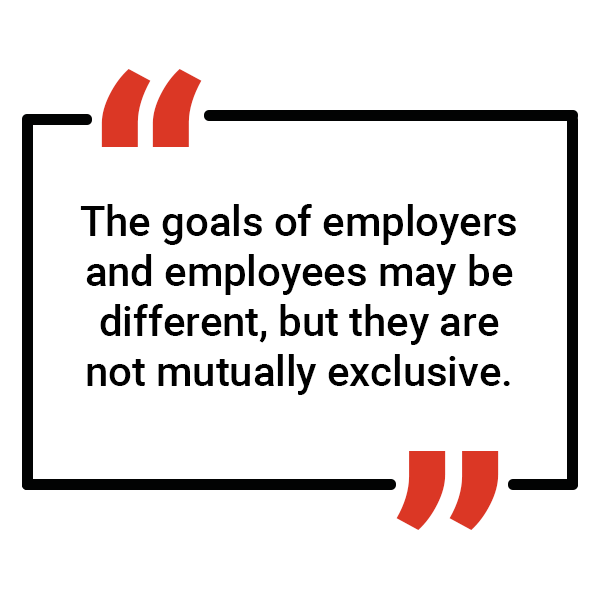Understanding employee motivations in today’s workplace

What motivates employees? What motivates employers? Understanding people’s motivations is key to keeping them engaged and maximizing performance.
The mystery behind employee motivation
Today, we are witnessing a generational shift away from the employer-based motivation of company ethos, mission, vision and culture toward a new era of employee motivation that’s centered on answering, “How does this organization benefit my personal growth story and provide me with career growth opportunities?”
Could it be that many employers spend too much time trying to influence employees’ motivations instead of listening and understanding what employees say they want the organization to provide? Do employers ignore the signs and plow right through a four-way stop, so to speak? If so, whom does that serve?
Here, we’ll take a closer look at the employee–employer disconnect and how employers and employees alike can move toward a more productive relationship based on communication.
Understanding the employee–employer disconnect
If employees openly state that their bottom-line salary is what motivates them, employers might jump to the conclusion that this is a negative. They might feel it’s antithetical to a team-player mindset and that an employee who values salary above all else is not one who embodies the type of culture they want to create in their organization.
Sometimes, employers want to hear that the company’s focus and mission are what matter most to employees. But when those same employers provide business operational status updates to shareholders every month, what do those shareholders want to know about? Profit and loss, EBITDA (earnings before interest, taxes, depreciation and amortization), operating cash flow, revenue and gross margin.
Money, in other words. (Or, more professionally, the financial metrics.)
In many organizations, it’s only after they have that information that shareholders ask, “Oh by the way, how are the people doing?” So why are employers shocked when employees have essentially the same monetary motivation?
Instead of seeing employee motivation via salary increase as a bad sign, maybe employers should look at it as a golden opportunity to create synchronicity. Let’s dive into a few common employer–employee situations where motivation can either stymie progress or enable everyone to flourish.
Values: How modern employers and employees differ
Employer motivation
Employers set organizational values because those provide the framework for the mission statement, and they guide the direction employers would like the company to move in. Values also set the tone for how employees and employers interact with each other and with their customer base.
Employers who provide good values to their teams, the kind that resonate with employees and society at large, have a better chance for organizational success.
Employee motivation
From employees’ point of view, are there advantages to tailoring a company’s values to individual workers? Instead of assuming organizational values should be immutable and employees must conform to them, could it be a good thing to encourage employees to organically adapt and develop workplace values so they reflect both the organization’s goals and those of employees?
The compromise
Understanding employee motivation means employers can incentivize employees effectively. So, if an employee values education, the company might cover the cost of a degree, certificate or certification, viewing it as an investment in employee growth. If an employee values professional growth and advancement, a company can collaborate with the employee to assess which training or program is most effective in offering the skills that will align with promotions. If the employee values salary, how can the employer secure the highest salary possible while staying within budget and pay-scale parameters?
Often, the answer involves compromise. For example, I had an employee I wanted to promote to upper management. He was ecstatic to receive the promotion, but he believed he should get a $20,000 pay increase above our allotted budget for the position. This was problematic since that kind of pay raise would’ve had him earning $20,000 more than other managers of the same rank.
The employee escalated the issue to leadership, and both parties dug in. The employer felt the employee only cared about money, and the employee felt he wasn’t being compensated fairly.
In the end, I was able to negotiate a $10,000 raise for the employee and a Project Management Professional (PMP®) boot camp valued at $5,000, which made all parties happy. Had I not mediated between the employer and employee and bridged the gap, it could’ve soured the relationship.
Employers must essentially connect the employee motivation to ways those can support the organizational mission and goals. This method, which relies on communication and innovation, essentially empowers employees and employers alike to meet their goals without sacrificing organizational values or employee individuality. In other words, it should be a mutually beneficial partnership.
Company culture: Employees vs. employers
Employer motivation
To an employer, “culture” can typically be defined as what the company stands for. Employers generally want to build a sense of community, opportunity and purpose for employees. If employers do that well, they can make employees feel as if they are contributing to a cause that’s greater than themselves. Employers also usually want to create a healthy and pleasant workplace with the goal of nurturing an attitude of advocacy from the employee. When employees are proud of their company, they share that with the world through conversations, partnerships, social media posts and more.
Employee motivation
Employees want to work in an organization where the experience is both meaningful and positive. They want to spend their days in an environment that benefits their mental health. Generally, this hinges on supportive management and a culture in which everyone is treated with respect.
The compromise
Meeting both employer and employee goals with regard to company culture often boils down to communication to find common ground. The goals of employers and employees may be different, but they are not mutually exclusive.
And when they are exclusive, finding a compromise that benefits both parties is a desirable outcome born from communication.
Employers should strive for maximum honesty and transparency with regard to career trajectories and compensation opportunities for employees. Additionally, employers who share business performance metrics, business development pipeline opportunities and strategic direction and vision with their employees create a culture of understanding and trust that benefits everyone.
Another way for employers and employees to meet their goals is through company rewards and recognition. Employees appreciate incentives like bonuses and perks: They are a way for employers to validate that an employee’s work is noticed and appreciated. They also motivate employees to do their best work and stay with the organization.
Although some employers take an adversarial view of remote work, offering a flexible schedule can be a powerful motivator to employees. Being remote isn’t possible for all functions in an organization, but when it does work, employees appreciate the autonomy.
In my company, for example, we had a manager who was vital to our operations. Although he enjoyed his job, he was becoming exhausted by his two-hour daily commute. Our organizational culture, however, emphasized the importance of working on-site every day.
Knowing this, the manager eventually decided to resign.
Our company stood to lose a valuable employee. Instead, we listened to his frustrations and ultimately accommodated his need to work remotely part of the week.
In the end all parties were happy. The commute burden was lifted from the employee and the organization was able to keep a valued manager on staff and happy.
Allowing one or two days of remote work per week can build a company culture where quality of life matters and therefore foster further employee motivation. And employees aren’t the only ones to benefit. What may surprise employers is how those rock-star employees still show up in the office a good deal of the time. They appreciate the freedom and privilege of being able to work on their own schedule and reward employers with their best work possible.

Employee motivation takeaway
Employee motivation stems from positive reinforcement. They want to be called into management’s office for a one-on-one session in which the employer confirms what a great job the employee is doing, that they have unlimited potential and that they can achieve anything they set their mind to.
This positive reinforcement, as the young people say, “puts a battery in their back” and gives them a jolt of motivational electricity to give their best to the job.
But that’s not always possible. And when the news is not great, or the feedback isn’t rainbows and unicorns, transparency goes a long way toward aligning employee and employer motivations.
Sometimes employers believe employees should make more money or be promoted ahead of schedule, but the organization can’t afford the pay increase, or the position doesn’t exist. When that happens, an employee might be offered a promotion without a raise. And while it may seem counterintuitive to accept a promotion without a raise, a 2020 article on LinkedIn® noted that more than 60% of workers are willing to accept it for the experience and recognition.
The flip side? Be ready for that employee to negotiate a raise at some point in the near future.
Ultimately, aligning employee and employer motivations is about meaningful compromise. Everyone needs to come to the table prepared to both give and get the most they can. In this way, both employers and employees find satisfaction and success.
ABOUT THE AUTHOR
Dr. Patrick C. Horton, MBA, DM/IST, is the vice president of program management for Tampa Microwave, a college professor and a veteran U.S. Army sergeant. He earned his Bachelor of Science in Information Technology, his Master of Business Administration and his Doctor of Management with a specialization in Information Systems at University of Phoenix. Dr. Horton launched his business, Professional Career Transformations, in 2021 as a way to guide and encourage others to higher levels of professional success. He is a member of Vistage Executive Coaching Group and a recipient of the Purple Heart in Operation Iraqi Freedom, and he lives in sunny Florida. Learn more about Dr. Horton and his commitment to helping others achieve their highest level of success by visiting his website.
The views expressed in this article are those of the author and do not necessarily reflect the advice of University of Phoenix.
Read more articles like this:



